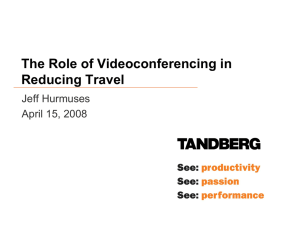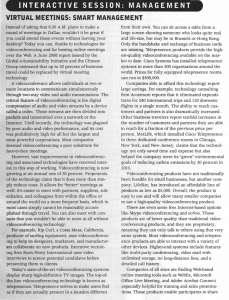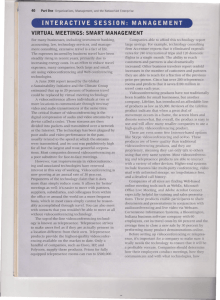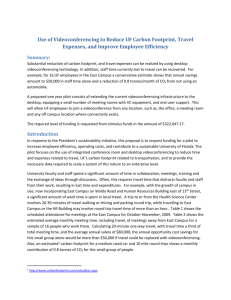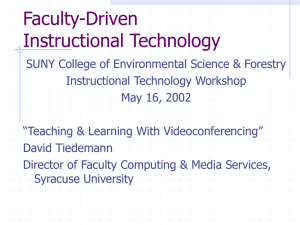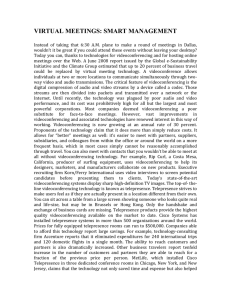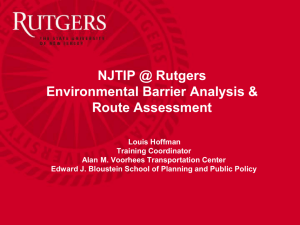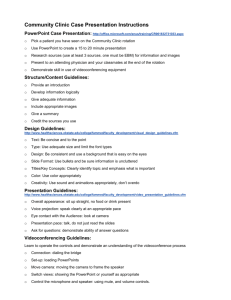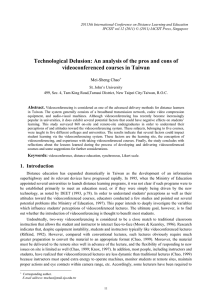Internet Video Conferencing
advertisement
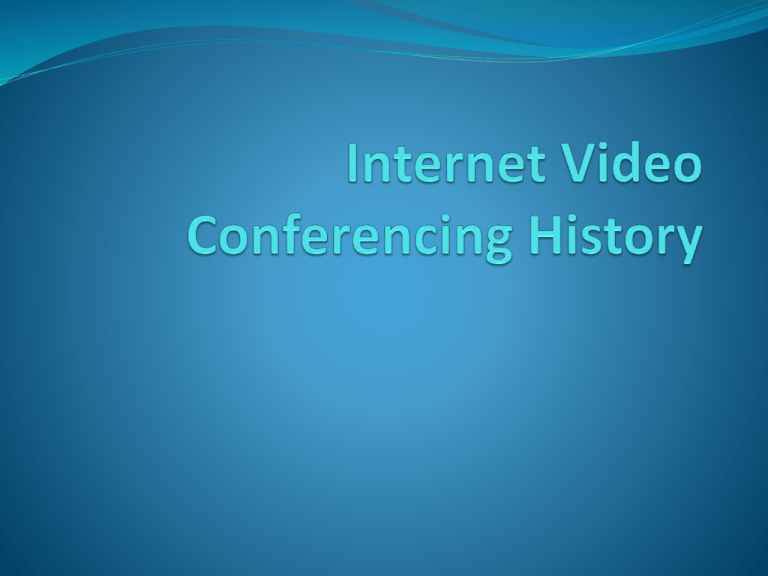
… a rose by any other name • • • • Internet videoconferencing IP-based videoconferencing (Internet Protocol) Web-based videoconferencing Desktop video conferencing as opposed to (but still existing) • • • System-based or room-based videoconferencing VTC (video teleconferencing) Telephony (POTS) videoconferencing Traditional vs. Internet Use in dedicated room Ubiquity – use anywhere Use of ISDN or T1 lines Leverages internet usage High installation costs Low installation costs High usage costs No/Low usage costs Usage at plateau Growing acceptance Resource scheduling Impromptu, ad hoc nature Technical operator Self-sufficiency model Centralized control Decentralized control H.320 standard H.323 standard What is it? • two-way or more (multipoint) video & audio communication • over a standard high speed internet connection • with standard quality of 30 frame per second video quality • using unique IP addresses for • reliable high speed internet connection (450kbps) … some agreed upon basics Long existing opinions: • Videoconferencing was a “next-year” technology • Limited application but not mainstream • Fine for Boardroom but not the classroom • Technologies were • too cumbersome or • too expensive and • loses the power of the face-to-face presence Long existing proposal: • 1964 Worlds Fair in New York • AT&T unveils the "PicturePhone“ to the public • AT&T vision: • PicturePhone centers nationwide (New York, Chicago) • Estimated rate of $30 for a three-minute call • Installed only at AT&T centers • Very worst of traditional VTC proposals • By 1970’s AT&T had extremely limited deployment, so they revamped for business taking and took video out of the Picturephone. The 1970’s • Ericsson (Sweden) successfully demonstrates the trans-Atlantic LME video telephone call • 1973: Network Voice Protocol (NVP) • released by the Information Sciences Institute (ISI) of USC (U. of Southern California • pioneered a computer network protocol for transporting human speech over a packetized communication network. • an early example of Voice over Internet Protocol (VoIP) technology. • 1976: Nippon Telegraph and Telephone establishes videoconferencing bridge between Tokyo and Osaka • Infrastructure, bandwidth, & acceptance all lacking The Big Eighties • Packet Video Protocol (PVP) in 1981 •extensions to NVP that standardize transmission protocol for video • 1982: IBM Japan/US build 48,000 bps internal VTC links • 1982 - Compression Labs introduces VTC product • $250,000 per unit with dedicated line cost = $1,000 per hour • system commonly trips simple 15 amp circuit breakers • 1986 - PictureTel introduces their VC offering • $80,000 per unit with dedicated lines at $100 per hour • beginning deployment in corporate environments • AT&T continues (estimated R&D costs near $1 billion) • Datapoint unveils the Multimedia Information Network eXchange (MINX) system early picture-in-picture VC solution • source of extensive income from patent infringements rather than product sales • Into the Nineties (pt. 1) • • • • • Internet Protocol (IP) technical advances Video compression technologies advance Ubiquity of desktop PCs Explosion in business & consumer use of internet in 1991: IBM introduced PicTel • early PC-based vtc system • black and white system • low-resolution • purchase costs of $20,000 per unit • estimated operating costs of $30 per line an hour Into the Nineties (pt. 2) • 1991 - DARTnet connects a transcontinental IP network • 12 research sites in the U.S. and the U.K. • Use of T1 trunk lines (not true IPVC)• DARTnet, now known as the CAIRN system, still exists • Late 1990’s: beginning IPVC • Embedded within services & software offerings such as NetMeeting (Win95) • MSN Messenger (1999) • Yahoo Messenger (1998) • Common Traits: • • poor video quality direct costs to consumers drove moderate adoption • adjunct to unified communication and web conferencing • Into the Nineties (pt. 3) • CU-SeeMee (Cornell University) • 1992: Apple Macintosh launches with CU-SeeMe (no audio) • Part of 1993 Global Schoolhouse (an NSF funded education • • • • project) 1993: multipoint capability added 1994: Win-based CU-SeeMe 1995: CU-SeeMe released commercially CU-SeeMe successes: • • • • first referenced “video chat” term peer-to-peer connection methodology somewhat limited applications early adoption into school rooms and training facilities used in 1995 television broadcast of World News Now Into the Nineties (pt. 4) • 1992: AT&T returns with $1500 videophone (small success) • 1992: MBone (multicast backbone) system •. minimizes data requirements for multipoint audio/video-conferencing • free virtual network uses mrouters that can support IP multicast • enables access to real-time interactive multimedia on the Internet • negates need for tunneling protocols with older router environments • Novell IPX Networks introduced VocalChat • Microsoft NetMeeting (from PictureTel's Liveshare Plus) • 1996 Dec: Microsoft NetMeeting v2.0b2 with video arrives Into the Nineties (pt. 5) • Real momentum? The development and ratification of compatibility standards by the International Telecommunications Union (ITU) • ITU Standards Unleash Videoconferencing • ITU established the Standard H.263, which reduces bandwidth transmission for low bit-rate communications. • Other standards: • • • H.323 for packet-based multimedia applications MPEG-4 ver 2.0(by The Moving Picture Experts Group) an ISO standard for multimedia content Media Gateway Control Protocol (MGCP) • Session Initiation Protocol (SIP) in 1999. • • SIP offered even further advantages beyond H.323 Gained wide acceptance among developers and supporters (Microsoft) The New Millennium (pt. 1) • SIP evolves as it entered version 1.30 in November of 2000. \ H.323 ver 4.0 release • Explosive growth in cell/mobile phones. • •Samsung released MPEG-4 streaming 3G video cell -- huge overseas success • Microsoft announces XP Messenger fully supports SIP. • 9-11 Tragedy – outcomes • Economic downturn forces cuts to corporate & institutional budgets • • • Travel dramatically restricted & curtailed VTC is no longer a luxury but becomes a necessity Portable satellite videophones used for live battlefront broadcasts The New Millennium (pt. 2) • High-speed internet access available @ reasonable cost. • Video capture/display technologies reduced in cost. • Web cameras readily available (if not built-in) • Cost of PCs at all time low • • Broadband internet access geographically available Free/embedded functionality from leading web conferencing, instant messaging, and unified communication vendors The New Millennium (pt. 3) • IPVC in Higher Ed • Distance learning programs are mainstays of Education degrees • Students require/demand enhanced classes with more • • interactive classroom-like environments. Streaming video quality has increased while disruptive delays almost eliminate Videoconferencing commonplace at work, home, and schools. • • began providing various MPEG-4 video systems to universities in the U.S
